Box-Behnken response surface method combined with fingerprint to optimize the extraction process of total anthraquinone from Cassia seeds
Heng Wang, Chun-Cai Zou, Hai-Yan Yan
Pharmacy School of Wannan Medical College, Wuhu 241002, China
ABSTRACT Objective: The Box-Behnken response surface method combined with fingerprints was used to optimize the extraction process of total anthraquinone from Cassia seeds. Methods: A threefactor, three-level response surface test was conducted based on the single-factor test with comprehensive evaluation as the measurement index. The comprehensive evaluation indexes included the extraction rate of total anthraquinone of Cassia seeds or the equivalent amount of herbs per gram of total anthraquinone of Cassia seeds, the normalized value of peak areas of 5 index components such as aurantio obtusin in the fingerprint of each sample to 16 shared peaks and the similarity of fingerprints (the reference fingerprint was established by the extraction solvent for the determination of Cassia seeds content in the Chinese Pharmacopoeia 2020 edition) with the weights of 0.2, 0.5 and 0.3, respectively. Results: The best extraction process was obtained: the liquid-to-material ratio was 20:1 (mL·g-1), the extraction solvent was mixture of 60% ethanol-ethyl acetate (2:1), and the extraction time was 15.12 min. The results of five sets of validation experiments showed that the overall evaluation of total anthraquinone of cassia seeds by the best process was 0.528 (RSD=0.45%), and the prediction result of response surface method model was 0.531, and the relative error with the prediction result was 0.531. The relative error of the predicted results was 0.56%, and the best extraction process was consistent with the model prediction, and the obtained best process could be used for the extraction of total anthraquinone from Cassia seeds. Conclusion: The Box-Behnken response surface method combined with the fingerprint technique can be used to find the best reaction conditions and examine the interactions among the factors in a comprehensive and accurate manner, which can provide reference for the optimization and evaluation of the extraction process of Chinese medicine.
Keywords:Cassia seeds Total anthraquinone Fingerprint Response surface design method
1. Introduction
Cassia obtusifolia L. or Cassia tora L. is a dried mature seed of Cassia obtusifolia L., a leguminous plant with sweet, bitter and salty taste and slightly cold nature, which is good at entering the liver, kidney and large intestine meridians and has the effect of clearing the liver and improving eyesight, laxative and laxative[1-3]. Cassia seeds were first recorded in Shennong Ben Cao Jing,and have a long history of use in China, and were also listed as one of the traditional Chinese medicines with the same source of medicine and food by the former Ministry of Health [4], which has great potential for application in the healthcare industry.Modern pharmacological studies have shown that cassia seeds have pharmacological effects such as hypotension, hypolipidemia,antiplatelet aggregation, immunity, hepatoprotection, eye care,antioxidant, and antibacterial [5-6], and have a wide range of clinical applications, being a representative drug in Chinese medicine for the treatment of cardiovascular and cerebrovascular diseases,hyperlipidemia, and constipation [7]. Cassia seeds contain many components such as anthraquinone, naphthopyrones, fatty acids,polysaccharides, and amino acids, and the main component is total anthraquinone accounting for about 1% [7-9], which is also the main substance in cassia seeds to exert its medicinal effects, with a variety of pharmacological activities such as hepatoprotective,antioxidant, and antimutagenic [10], and has received key attention from pharmacology related personnel.
In the content determination of total anthraquinone compounds of Cassia seeds, such as chrysophanol and aurantio-obtusinin the first volume of Chinese Pharmacopoeia (2020 Edition), methanol is used as the extraction solvent to extract the total anthraquinone compounds, dilute hydrochloric acid is used to hydrolyze the combined anthraquinone to obtain the total anthraquinone, and then absolute ethanol ethyl acetate (2:1) is used as the constant volume solvent for content determination. Analyze the price and toxicity of the extraction solvent and the use of a large amount of extraction in production.Considering the coexistence of free anthraquinone and bound anthraquinone in cassia seed, combined with the quantitative analysis of free anthraquinone compounds after hydrolysis with absolute ethanol ethyl acetate (2:1) in Chinese Pharmacopoeia 2020 edition, this study intends to investigate the effects of different concentrations of ethanol and ethyl acetate (2:1) mixed solvents on the extraction process of total anthraquinone compounds in Semen Cassiae based on response surface design and traditional Chinese medicine fingerprint technology, and determine the optimal extraction process parameters of total anthraquinone in Semen Cassiae, so as to lay a foundation for the pharmacological and pharmacodynamic study of total anthraquinone in Semen Cassiae in the later stage.
2. Materials and Methods
2.1 Instruments
FA2004B electronic balance (Shanghai Yue Ping Scientific Instruments Co., Ltd.); Shimadzu UV-20A high performance liquid chromatograph (Shimadzu Corporation); DZF-6090 type vacuum drying oven (Shanghai Sanfa Scientific Instruments Co., Ltd.);Heidolph-LR4010/4011 rotary evaporator (Germany Heidolph Corporation); DF-I collector magnetic heating stirrer (Changzhou Ltd.); KQ-250DE type CNC ultrasonic cleaner (Kunshan Ultrasonic Instrument Co., Ltd.); RHP-400A type high-speed multi-functional pulverizer (Zhejiang Yongkang Ronghao Industry and Trade Co.,Ltd.).
2.2 Materials
Cassia seeds (stir fried product product, Beijing Tongrentang Cheng'an Medicinal Materials Co., Ltd., Lot No.: 2019073103,2020011901); Aurantio-obtusin (Chengdu Pfeiffer Biotechnology Co., Ltd., Purity: ≥98%, Lot No.: 17032405); Emodin (National Engineering Research Center of Traditional Chinese Medicine Solid Preparation Manufacturing Technology, Purity: ≥98%, Lot No.: D03-140210); Rhein (National Engineering Research Center of Traditional Chinese Medicine Solid Preparation Manufacturing Technology, Purity:≥98%, Lot No.: D05-140210) ); Chrysophanol(Chengdu pfield Biotechnology Co., Ltd., purity: ≥ 98%, Lot No.: 17032204); Emodin methyl ether (National Engineering Research Center for manufacturing technology of solid preparations of traditional Chinese medicine, purity ≥ 98%, Lot No.: D04-140210); Anhydrous ethanol (Anhui ante Food Co., Ltd., Lot No.:210307363604) and ethyl acetate (Shanghai Zhanyun Chemical Co.,Ltd., Lot No.: 20210220) are analytical pure; Methanol (Tianjin kemio Chemical Reagent Co., Ltd., Lot No.: 20160129) and acetonitrile (Jiangsu Yonghua Chemical Technology Co., Ltd., Lot No.: 20151102) are chromatographic pure, and water is deionized water.
2.3 Methodology
2.3.1 Preparation of the solution
2.3.1.1 Preparation of total anthraquinone extract of cassia seeds
Take about 5.0 g of cassia seed powder (sieved by No.3), weigh it precisely, put it in a 250 mL round bottom flask, add a solution mixed with ethanol and ethyl acetate at a certain concentration of 2:1(mL:mL) according to a certain liquid to material ratio, extract it 3 times by reflux in a water bath, each time to a specified time, extract it by filtration, concentrate the combined filtrate to a certain volume under reduced pressure, wash it out with 60% ethanol, evaporate the solvent in a water bath,the total anthraquinone extract of cassia seeds was obtained by vacuum drying (pressure - 0.1 MPa, temperature 70℃, the same below) for 48 h.
2.3.1.2 Preparation of total anthraquinone test solution of Cassia seeds
Take about 0.5 g of the total anthraquinone extract of Cassia seeds under "1.3.1.1", accurately weigh it, add 30 mL of dilute hydrochloric acid, reflux in a water bath for 1 h, cool immediately,extract 5 times with dichloromethane, 30 mL each time, combining the dichloromethane solution and recover the solvent,the residue was washed out with anhydrous ethanol-ethyl acetate (2:1), transferred to a 25 mL flask and fixed with anhydrous ethanol-ethyl acetate (2:1) to the scale to obtain the total anthraquinone solution of Semen cassia,and set aside.
2.3.1.3 Preparation of Cassia Seed total anthraquinone reference solution
According to "Chinese Pharmacopoeia" [1], a reference solution of total anthraquinone of Cassia seed was prepared. Take about 5.0g of Cassia seed powder (passing through No. 3 sieve), accurately weigh it, add 500mL of methanol, heat to reflux for 2 hours, let cool, filter with suction, rotary steam to dryness, and vacuum dry to obtain the total anthraquinone extract of Cassia seed (reference product).Take 0.5g of total anthraquinone extract (reference product) of Semen cassia, weighed precisely, add 30mL of dilute hydrochloric acid, hydrolyze in water bath for 1 hour, cool immediately, extract 5 times with dichloromethane, 30mL each time, combine the dichloromethane solution, recover the solvent, dissolve the residue with anhydrous ethanol-ethyl acetate (2:1), transfer to a 25mL measuring flask, and fix with anhydrous ethanol-ethyl acetate (2:1)The total anthraquinone reference solution of Cassia serrata was obtained and set aside.
2.3.1.4 Preparation of reference solution
Take appropriate amounts of five reference substances, cassia orange, emodin methyl ether, chrysophanol, emodin, and rhein, and accurately weigh them. Place them in a measuring flask and prepare them with absolute ethanol-ethyl acetate (2:1). A stock solution of reference substance with a mass concentration of 200 μg/mL. Then accurately draw appropriate amounts of the five reference substance stock solutions, place them in a measuring flask, and prepare a mixed reference substance solution with a mass concentration of 12 μg/mL with absolute ethanol-ethyl acetate.
2.3.2 Establishment of fingerprint atlas
2.3.2.1 Chromatographic conditions [11]
Chromatographic column YMC-Pack ODS-A C18 ( 250 mm× 4. 6 mm, 5 μm); mobile phase A (acetonitrile)-B (0.1% phosphoric acid),gradient elution, analysis time 100 min:0~15 min,65%~65%B;15~18 min,65%~68%B;18~23 min,68%~68%B;23~25 min,68%~65%B;25~45 min,65%~50%B;45~63 min,50%~45%B;63~85 min,45%~45%B;85~100 min,45%~10% B.The column temperature was 30 ℃; volume flow rate: 1 mL /min; detection wavelength 287 nm.
2.3.2.2 Precision test
Take 5.0 g of Cassia seed powder, accurately weigh it, prepare the test solution according to the method under "1.3.1.2", inject 5 consecutive samples according to the chromatographic conditions under "1.3.2.1", and record the chromatogram. The RSD values of the retention time of orange cassia, rhein, emodin, chrysophanol,and emodin methyl ether were calculated to be 0.026%, 0.033%,0.012%, 0.017%, 0.023%, and the RSD values of the peak areas were 0.14. %, 0.081%, 0.54%, 0.24%, 0.64%, indicating that the method has good precision.
2.3.2.3 Repeatability test
Take 5 parts of the same batch of Cassia seed powder, each 5.0 g,accurately weigh, prepare the test solution in parallel according to the method under "1.3.1.2", inject the sample under the chromatographic conditions under "1.3.2.1", and record the chromatogram. The results showed that the RSD values of the retention time of orange cassia,rhein, emodin, chrysophanol, and emodin methyl ether were 1.1%,1.3%, 0.49%, 0.68%, 0.78%, and the RSD values of the peak area were 3.4. %, 3.2%, 3.4%, 3.0%, 2.6%, indicating that the method has good repeatability.
2.3.2.4 Stability test
Take the same solution of the test product and analyze it at 0, 3,6, 9, and 12 h according to the chromatographic conditions under"1.3.2.1", and record the chromatogram. The results showed that the RSD values of the retention time of orange cassia, rhein, emodin,chrysophanol, and emodin methyl ether were 0.038%, 0.047%,0.11%, 0.014%, 0.20%, and the RSD values of the peak area were 0.39%, 0.97%, 0.61%, 0.22%, 0.72%, indicating that the test solution is stable within 12 hours.
2.3.3 Single-factor test
According to the methods under "1.3.1.1" and "1.3.1.2", 5 g of cassia seed powder was taken, weighed precisely, and extracted three times, and the liquid to material ratio (5:1, 10:1, 15:1, 20:1,25:1 mL·g-1), extraction solvent (40%, 50%, 60%, 70% and 80%ethanol mixed with ethyl acetate as extraction solvent at 2:1 ratio)and extraction time (15, 30, 45, 60 and 75 min) were investigated respectively. The effects of the extraction ratios (5:1, 10:1, 15:1,20:1, 25:1 mL·g-1), extraction solvents (40%, 50%, 60%, 70%and 80% ethanol mixed with ethyl acetate in the ratio of 2:1) and extraction times (15, 30, 45, 60 and 75 min) on the extraction rate of total anthraquinone from cassia seeds or the amount of total anthraquinone per gram of cassia seeds, the peak normalized values of the five index components (orange cassia, rhein, emodin,chrysophanol, and emodin methyl ether) [Xi% = (Ai/An)×100%, Ai is the sum of the peak areas of the five index components of the same sample under the same extraction conditions, An is the sum of the peak areas of the common peaks of the same sample under the same extraction conditions] and the similarity of the control fingerprints(the fingerprints obtained from the reference solution under"1.3.1.3" are the reference fingerprints S1, based on the similarity with the control fingerprints generated from the fingerprints of the test solution, hereinafter) were investigated, and determine the comprehensive evaluation (R) results.Comprehensive evaluation(R) = extraction rate of total anthraquinone from cassia seeds (or equivalent amount of herb per gram of total anthraquinone from cassia seeds) * 0.2 + normalized value of peak areas of five index components * 0.5 + similarity of control fingerprint profiles * 0.3 (in the formula, 0.2, 0.5 and 0.3 are weighting coefficients reflecting the contribution of each factor to the comprehensive evaluation).
2.3.4 Box-Benhnken response surface optimized extraction process
According to the principle of Box-Behnken experimental design,the extraction rate, normalized value of peak area, similarity of control fingerprint profile and comprehensive evaluation results were used as indicators, and three influencing factors of liquid to material ratio (A), ethanol concentration (B) and extraction time (C) were selected on the basis of single-factor test, and a three-factor, threelevel test was designed using Design-Expert 8.0 software [12], and the table of factors and levels is shown in Table 1.

Table 1 Factors and levels in Box-Behnken design
3. Results
3.1 Establishment of fingerprint profiles and confirmation of shared peaks
Prepare the test solution of the total anthraquinone of Cassia seed according to the method of "1.3.1.2", inject the sample under the chromatographic conditions under "1.3.2.1", record the chromatogram, and import it into the "Chinese Medicine Chromatographic Fingerprint Similarity Evaluation System"developed by the National Pharmacopoeia Commission(2012.130723 version), establish a fingerprint map. Taking the fingerprint spectrum obtained from the reference solution of Cassia seed total anthraquinone under "1.3.1.3" as the reference spectrum S1, after multi-point calibration, a total of 16 common peaks were confirmed by Mark peak matching; Five marker peaks of the total anthraquinone extract of Cassia seeds were confirmed using the consistency of the chromatographic peaks of the fractions to be identified in the Cassia seeds test sample and the retention times of the peaks of the five controls[13]. They are aurantio-obtusin, rhein,emodin, chrysophanol, and emodin methyl ether, as shown in Figure 1.
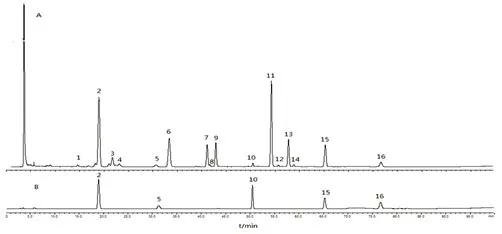
Figure 1 HPLC plots of Cassia seeds test solution (A) and mixed reference substances (B)
3.2 Effect of single factors on the extraction efficiency of total anthraquinone from Cassia seeds
3.2.1 Effect of liquid to material ratio on the overall evaluation (R)
Based on the results of the pre-experiment, the extraction solvent was determined as 60% ethanol-ethyl acetate (2:1) mixture, and the extraction time was 90 min. The effects of the liquid to material ratios of 5:1, 10:1, 15:1, 20:1 and 25:1 (mL·g-1) on the extraction yield (%), normalized peak area (%) and similarity of the control fingerprint profiles were investigated, and the comprehensive evaluation (R) results were calculated. The results are shown in Table 2 and Figure 2.As shown in Table 2 and Figure 2, the extraction rate (%) was the highest and the normalized peak area (%) was the largest at the liquid to material ratio of 15:1 (mL·g-1); the similarity of the control fingerprint profiles of each group ranged from 0.95 to 1.00,indicating that the number of common peaks remained consistent among the groups and the peak areas of the common peaks did not fluctuate too much or too little under the influence of the liquid to material ratio; the overall evaluation of the total anthraquinone extraction of cassia seeds gradually improved with the increase of the liquid to material ratio (mL·g-1). The overall evaluation of total anthraquinone extracted from cassia seeds gradually improved with the increase of the liquid-to-material ratio (mL·g-1), and reached the highest score of 0.514 at the liquid-to-material ratio of 15:1(mL·g-1), after which the overall evaluation of total anthraquinone gradually decreased with the increase of the liquid-to-material ratio.Therefore, the optimal extraction liquid to material ratio was 15:1(mL·g-1).
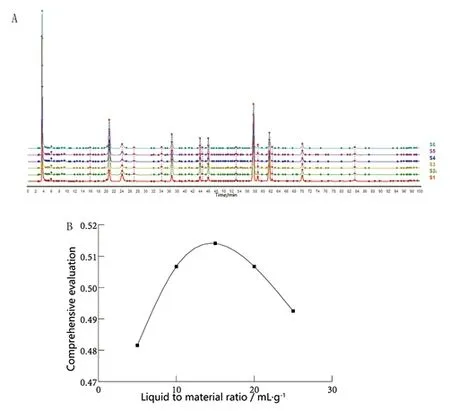
Figure 2 Effect of liquid-to-material ratio on HPLC fingerprints (A) and comprehensive evaluation (B) of cassia seeds

Table 2 Effect of liquid to material ratio on comprehensive evaluation
3.2.2 Effect of extraction solvent on the comprehensive evaluation (R)
The liquid to material ratio was determined as 15:1 (mL-g-1),and the extraction time was 90 min. The effects of the extraction solutions of 40%, 50%, 60%, 70% and 80% ethanol mixed with ethyl acetate in a 2:1 ratio as extraction solvents on the equivalent raw drug content of cassia seed extract per gram (referred to as equivalent raw drug content) (%), peak area normalized values (%)and control fingerprint profiles were investigated. The results are shown in Table 3 and Figure 3.

Figure 3 Effect of extraction solvent on HPLC fingerprints (A) and comprehensive evaluation (B) of Cassia seeds
In this investigation of extraction solvents, the ethanol concentration ranged from 40% to 80%, with a wide range of variation. At low ethanol concentration, the extraction rate of anthraquinone glycosides component will increase, while the free anthraquinone extraction rate will decrease, and the water-soluble impurities extracted will increase significantly; at high ethanol concentration, the extraction rate of anthraquinone glycosides component will decrease, while the free anthraquinone extraction rate will increase. Therefore, in this examination of extraction solvents, it does not mean that the higher the extraction rate of the extract is, the better the extraction solvent is, because the purity of that extract may not be higher. Therefore,the amount of raw drug per gram of cassia extract was used as an indicator, and the data were processed by polarization so that the data fell between [0, 1] [14]. Also, the normalized value of peak area(%) and the similarity of the control fingerprint profile should be considered.
From Table 3 and Figure 3, it can be seen that at 70% ethanol, the highest raw drug content per gram of cassia extract was equivalent to cassia seeds, but the normalized value of peak area was not the highest, and the similarity of the control fingerprint profile was in the range of 0.985 to 0.995, indicating that the number of shared peaks remained consistent among the groups, and the peak areas of the shared peaks did not fluctuate too much or too little by the extraction solvent.The comprehensive score was calculated, and when the ethanol concentration was 70%, the overall evaluation score of the total anthraquinone extraction was the highest.
3.2.3 Effect of extraction time on the comprehensive evaluation (R)
The liquid to material ratio was determined as 15:1 (mL·g-1)and the extraction solvent was 70% ethanol-ethyl acetate (2:1).The effects of extraction time of 15, 30, 45, 60 and 75 min on the extraction rate (%), normalized value of peak area (%) and similarity of control fingerprint profiles were investigated, and the results of comprehensive evaluation (R) were calculated. See Table 4 and Figure 4.

Table 3Effect of extraction solvent on comprehensive evaluation

Table 4 Effect of extraction time on comprehensive evaluation
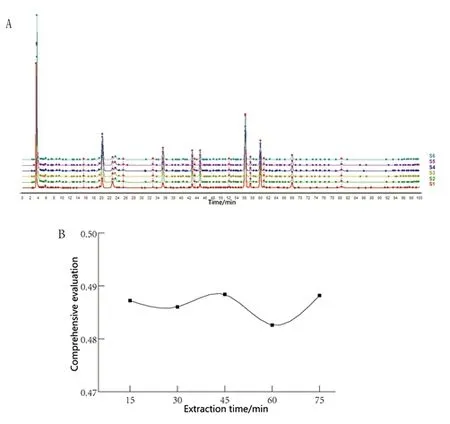
Figure 4 Effect of extraction time on HPLC fingerprints (A) and comprehensive evaluation (B) of cassia seeds
In the investigation of the liquid-to-material ratio and extraction solvent, the extraction time was set to 90 minutes in accordance with the extraction time under the content determination of Cassia seed in the 2020 edition of the Chinese Pharmacopoeia. Although the setting of the extraction time does not affect the study of the liquidto-material ratio and the extraction solvent, the study found that on the basis of 3 extractions, the 90min setting time is too long. For this reason, the inspection points of extraction time are set at 15, 30, 45,60, and 75 min.
It can be seen from Table 4 and Figure 4 that the extraction rate and peak area normalized value of Cassia seed at different extraction time points are relatively close, with RSDs of 2.1% and 2.2%,respectively, and the similarity of the control fingerprints is greater than 0.99. The comprehensive evaluation reached the highest value at 45 min. Considering that the comprehensive evaluation of total anthraquinone at 30 and 45 min is very similar, and when the response surface is optimized in the later stage, 45 min will be used as the three-level upper limit time point of the investigation time point, so the extraction time is selected 30 minutes.
3.3 Response surface optimization of extraction process
3.3.1 Response surface test results and analysis of variance According to Table 1 Response surface test factors and levels table,the quadratic response surface regression analysis was performed by Design-Expert 8.0 software, and the experimental design and results are shown in Table 5, and the multivariate quadratic response surface regression model was obtained.
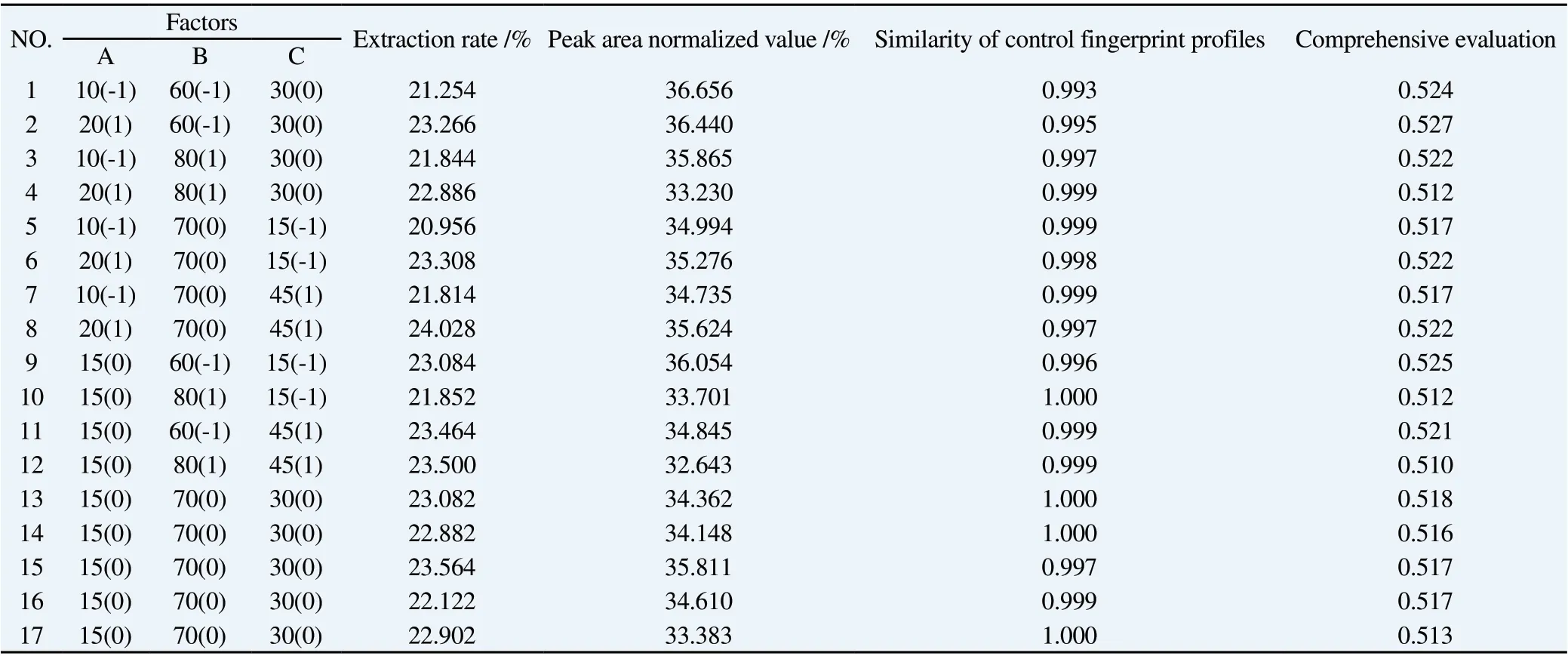
Table 5 Response surface test design and results
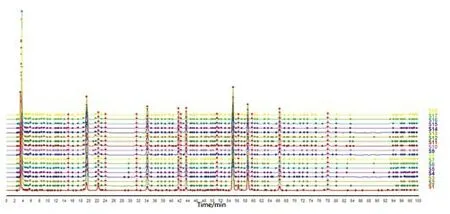
Figure 5 Response surface analysis of 17 HPLC fingerprints of cassia seeds
The HPLC fingerprints of cassia seeds were established in 17 groups of response surface tests, and the fingerprints obtained from the reference solution under "1.3.1.3" were used as the reference spectrum S1, and the normalized values of peak areas of the five index components and the similarity of the control fingerprints were analyzed and calculated by using the software of "Similarity Evaluation System for Chromatographic Fingerprints of Chinese Medicines". Combined with the total anthraquinone extraction rate of cassia seeds, the comprehensive evaluation (R) was confirmed.It can be seen from Table 5 and Figure 5 that the total anthraquinone extraction rate of Cassia seed varies from 20.956% to 24.028%, and the normalized value of peak area varies from 32.643% to 36.656%under different factors and level combinations, indicating that the total anthraquinone extraction rate and peak area normalized value of Cassia seed have a greater impact; the similarity of the control fingerprints is greater than 0.99, indicating that each sample and the reference solution under different extraction processes are similar in the number of peaks and the overall evaluation of the peak area.The results of the regression model analysis of variance are shown in Table 6.
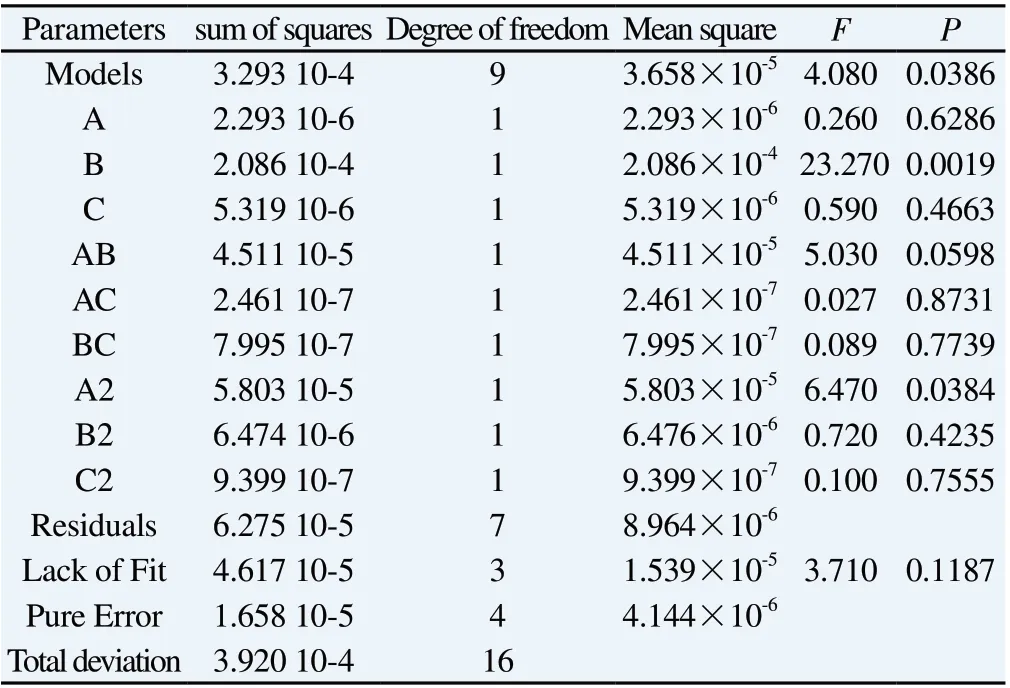
Table 6 Regression model analysis of variance
It can be seen from Table 6 that the concentration of ethanol (B)has a very significant effect on the extraction of total anthraquinones(P<0.01). Model P<0.05, indicating that the regression model is credible; lack-of-fit term P=0.1187>0.05, no significant difference,indicating that the model fits the experimental data to a high degree,and the error is small. This model can be used to analyze and predict the relationship between the influencing factors and response values in the extraction process of total anthraquinone from Cassia seed. F can reflect the influence of various factors on the test. The larger the F value, the more significant the influence of this factor on the test results [15]. From the F value, it can be found that among the three factors set, each factor has an effect on the cassia seed. The influence degree of total anthraquinone extraction efficiency is ethanol concentration (F=23.27)>extraction time (F=0.59)>liquid to material ratio (F=0.26) [16].
The residual normal probability analysis result of the model is shown in Figure 6.
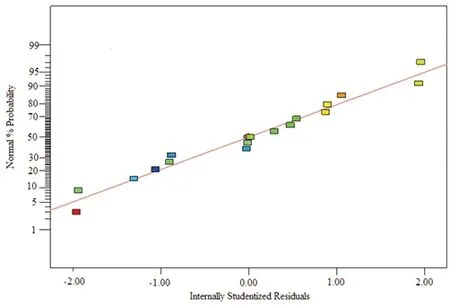
Figure 6 Normal plot of residuals
As can be seen from Figure 6, the residual normal probabilities of the model were basically distributed on the same line with R2= 0.9685, indicating that the actual measured values of the comprehensive evaluation of total anthraquinone of cassia were less different from the model predicted values.
3.3.2 Verification test
The 3D Surface plotted by Design-Expert 8.0 software can visually analyze the magnitude of the influence on the response values among the influencing factors, and the steeper the slope of the response surface, the more significant the interaction of the factor [17], see Figure 7. The optimal extraction process was optimized by using the comprehensive evaluation as the index, and the best extraction process was obtained as liquid to material ratio (A) = 20:1 (mL·g-1), extraction solvent (B) = 60% ethanol-ethyl acetate (2:1) mixture,and extraction time (C) = 15.12 min. 5 sets of validation tests were conducted for the optimized conditions, and the comprehensive evaluation score of total anthraquinone extraction from Cassia seeds was 0.528 (RSD=0.45%), and the model prediction score was 0.531, with a relative error of 0.56 % from the prediction score, so the regression model was accurate and reliable in predicting the comprehensive evaluation of the total anthraquinone extraction of Cassia seeds.
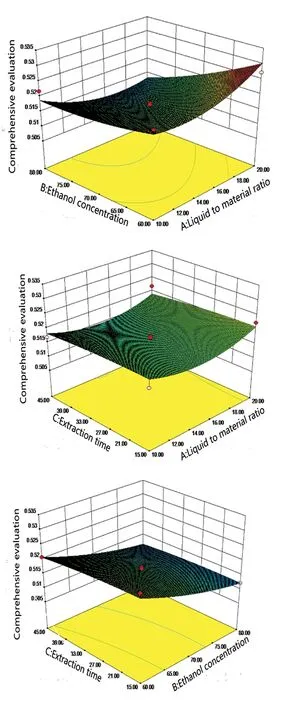
Figure 7 Effect of the interaction of various factors on the extraction effect of total anthraquinone from Semen cassia
4. Discussion
The Box-Behnken response surface method has been used for the optimization of the extraction process of traditional Chinese medicine extracts in the literature, and the evaluation indexes include extraction rate and active ingredient content, but there is no report on the combination of Box-Behnken response surface method and fingerprinting technique of traditional Chinese medicine for the optimization of the extraction process of traditional Chinese medicine extracts. The content determination of Cassia seed in the 2020 edition of the Chinese Pharmacopoeia uses methanol as the extraction solvent and absolute ethanol-ethyl acetate as the chrysophanol and orange cassia to determine the content of the two anthraquinone compounds. To this end, a mixture of ethanol and ethyl acetate (2:1) at different concentrations was selected as the extraction solvent for the extract of Semen cassia, and the Box-Behnken response surface method combined with the fingerprinting technique of traditional Chinese medicine was used to optimize the extraction process of total anthraquinone from Semen cassia.
The Box-Behnken response surface method can avoid the drawbacks of traditional collation statistics and accurately find the optimal reaction conditions and sensitively examine the interactions between the factors [18]. Fingerprinting of Chinese herbal medicines is a map that can indicate the common peaks of chemical properties of herbal medicines. The fingerprint of cassia seeds was established,and the common peaks were confirmed by Mark peak matching,indicating that the optimization of conditions would not lead to the absence of a component or the generation of a new compound. The similarity of the control fingerprints was calculated by using the fingerprints obtained from the reference solution prepared according to the Chinese Pharmacopoeia under "1.3.1.3" as the reference fingerprints and combining them with the fingerprints of the sample solution to generate the control fingerprints, which had a high and fluctuating similarity. The fluctuation of the similarity of the control fingerprint indicates that the extraction conditions mainly affect the peak area of the common peaks, i.e. the content of each component in the extract; the high similarity of the control fingerprint indicates that the influence of the variation of the extraction process on the common peaks has a certain balance, and the peak area of each component will not be too high or too low due to the variation of the extraction process, and the peak area of each component fluctuates around the corresponding peak area of the reference profile.
The extraction rate is one of the commonly used evaluation indicators in the process optimization of traditional Chinese medicine extracts, but the extraction rate setting should consider the polarity of the extract and the change of the polarity of the extraction solvent. This study is to optimize the extraction process of total anthraquinone from Cassia seed, and anthraquinone and anthraquinone glycosides are the main effective substances of total anthraquinone from Cassia seed[19], and they have different polarities. When the extraction solvent is polar, the extraction rate of anthraquinone glycosides and other polar substances will increase,while the extraction rate of anthraquinone will decrease; when the extraction solvent is less polar, the extraction rate of anthraquinone glycosides and other polar substances will decrease, while the extraction rate of anthraquinone will increase. Therefore, when investigating the influence of different concentrations of ethanolethyl acetate on the extraction process, it is more reasonable and reliable to use the amount of raw drug per gram of cassia extract instead of extraction rate as one of the evaluation indexes on the basis of ensuring the similarity of fingerprint characteristics and the high content of the five main index components.
In the calculation of the comprehensive evaluation (R), the weight coefficients 0.2, 0.5 and 0.3 were the contributions of the extraction rate, the normalized value of the peak area of the index component and the similarity of the control fingerprint profile to the comprehensive evaluation, respectively. Among them, the peak area normalized values of the five free anthraquinones of orange cassia,rhein, emodin, chrysophanol and emodin methyl ether are derived from the five free anthraquinones of the same sample under the same extraction conditions and the peak area and the ratio of the peak area sum to the 16 common peaks in the sample. These data come from the fingerprint of the sample. They are the result of the fingerprint data processing of the sample. It can comprehensively and intuitively reflect the extraction process’s influence on the 5 index components and The influence of 16 common peaks, so set the weight to 0.5.As a comprehensive and quantifiable quality evaluation method,fingerprint mapping can obtain comprehensive information on the overall characteristics of the chemical composition groups of traditional Chinese medicine. In this study, the fingerprints obtained from the reference solution prepared in the Chinese Pharmacopoeia were used as reference profiles, combined with the fingerprints of the sample solution to generate the control fingerprints, and their similarity was calculated to investigate the effect of changes in extraction conditions on the similarity of the control fingerprints, so the weight of the similarity of the control fingerprints was set to 0.3 on the basis of the weight setting of the normalized value of the peak area.
In this study, the extraction process of the total anthraquinone component of Cassia seeds was optimized, which can provide reference and reference for the in-depth research and application of the medicinal components of Cassia seeds.
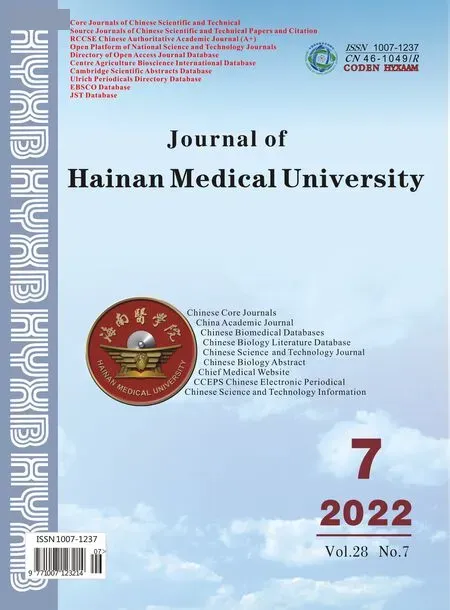 Journal of Hainan Medical College2022年7期
Journal of Hainan Medical College2022年7期
- Journal of Hainan Medical College的其它文章
- Analysis on medication rule of traditional Chinese medicine treating chemotherapy-induced diarrhea based on traditional Chinese medicine(TCM) inheritance computing platform system
- Study on medication rules of traditional Chinese medicine for Meniere's disease based on data analysis
- Efficacy and safety of traditional Chinese medicine in the treatment of coronary heart disease complicated with anxiety and/or depression after PCI: A systematic review and meta-analysis
- Effect of Xifeng Capsule on blood stasis in patients with rheumatoid arthritis by regulating miR-126-VEGF/PI3K/AKT signaling pathway
- Design and characterization of a bifunctional bybrid antibacterial peptide LLH for bactericidal/endotoxin neutralization effects
- Effect of Zhiyang Pingfu Liquid on epidermal growth factor receptor inhibitor-related skin lesion
